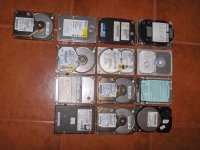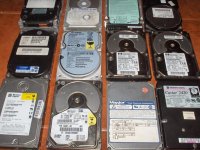Upcoming Events:
- VCF South West - June 14 - 16, Davidson-Gundy Alumni Center at University of Texas at Dallas
- VCF West - Aug 2 - 3, Computer History Museum, Mountain View, CA
- VCF Midwest - Sept 7 - 8 2024, Schaumburg, IL
- VCF SoCal - Mid February 2025, Location TBD, Southern CA
- VCF East - April 2025, Infoage Museum, Wall NJ
-
Please review our updated Terms and Rules here
You are using an out of date browser. It may not display this or other websites correctly.
You should upgrade or use an alternative browser.
You should upgrade or use an alternative browser.
Found 13 HDs!
- Thread starter ppo
- Start date
Dwight Elvey
Veteran Member
What kind? There are many different types.
Dwight
Dwight
It really depends what you're wanting to see, and what OS you're running. Essentially if you're wanting to look at the raw contents for shiggles you need any hex editor that supports opening devices/drives.
The helpful tools are things like a search and/or replace function if you're wanting to hunt around for specific data. If you really want to read the drive file system in-tact then you'll probably want some variation of a *nix boot disk or install then if you can ID the file system on that drive you can try loading the modules (drivers) and try to map the drive file system.
The helpful tools are things like a search and/or replace function if you're wanting to hunt around for specific data. If you really want to read the drive file system in-tact then you'll probably want some variation of a *nix boot disk or install then if you can ID the file system on that drive you can try loading the modules (drivers) and try to map the drive file system.
Chuck(G)
25k Member
But what if they're IBM 2311s? 
I'm with Dwight--what kind are they (interface, operating system, etc.)
I'm with Dwight--what kind are they (interface, operating system, etc.)
Ole Juul
Veteran Member
Like Dwight suggests, HD is a pretty wide concept. Since this is posted under vintage perhaps they are MFM, in which case you need to sort out the matching card if you want to read them. That could be troublesome, but as Chuck(G) points out, it could be even worse.
For looking at old disks I personally prefer dm.com (8Kb) from Michael Mefford (via PC-mag). I've explored hundreds of unknown hdds and thousands of "thrift store floppies" with that. I type pretty fast and it's the only program I know which can keep up with me on an explore. I move around by cding and hit dm to view when I see an interesting directory. Just put it on a bootable DOS floppy. Although those are the only 4 files you need (DOS and DM), throwing in cat, whereis, and particularly attrib could be handy. Attrib is a great substitute for the dir command. I particularly like the one by Charles Dye which comes from FreeDOS. A similar program to dm (dirmagic) which is a little slower to use, but much more sophisticated, is Verne Beug's list.com (27Kb).
For looking at old disks I personally prefer dm.com (8Kb) from Michael Mefford (via PC-mag). I've explored hundreds of unknown hdds and thousands of "thrift store floppies" with that. I type pretty fast and it's the only program I know which can keep up with me on an explore. I move around by cding and hit dm to view when I see an interesting directory. Just put it on a bootable DOS floppy. Although those are the only 4 files you need (DOS and DM), throwing in cat, whereis, and particularly attrib could be handy. Attrib is a great substitute for the dir command. I particularly like the one by Charles Dye which comes from FreeDOS. A similar program to dm (dirmagic) which is a little slower to use, but much more sophisticated, is Verne Beug's list.com (27Kb).
billdeg
Technician
I've found 13 HDs, and I want to know how can I see their contents.
What tools to use, programs, etc,
It's easy, just put them in a computer and use software to read the contents or send to a printer using a cable.
just kidding.
Look up the model number(s) online to get an idea of types of systems they'd be found typically. From my experience, loose hard drives have been removed from the computer for a reason, don't expect them to all work. Please post a complete list of the make/manufacturer/partnumbers/dimensions in order to get a useful reply.
Good luck!
krebizfan
Veteran Member
Hello again, just looked at them and they are all very recent taking one or another.
Here are some pictures:
I could recognise two drives. The Seagate ST1100 is about 20 years old with an MFM interface. Save this drive; MFM drives are difficult to find these days and someone will need one. The 2420 is an IDE drive made about 15 years ago.
To determine interfaces, need pics of the cable connectors (side on). There are about 8 standard types of pc internal connectors for hard disks plus some exotic vendor specific cables. Okay, even with a picture it will be difficult to tell the difference between 40-pin IDE and 50-pin SCSI or 68-pin SCSI but the MFM/RLL drives could be sorted out with ease.
Many manufacturers have excellent websites that let you search by model number.
Sure takes the guesswork out of figuring out what you have.
Sure takes the guesswork out of figuring out what you have.
smplfyi
Experienced Member
For MFM drives look at the individual PDF in my directory here
http://maben.homeip.net:8217/static/S100/DISK/specs/index.html
and more generally about MFM disks and emulators
http://maben.homeip.net:8217/static/S100/DISK/index.html
Call me heartless but I'd only value the MFM drives, early IDE/SCSI are really much of a muchness, a Compact Flash card plugged into a CF-IDE converter makes more sense for insertion into early PC's.
regards marcus
http://maben.homeip.net:8217/static/S100/DISK/specs/index.html
and more generally about MFM disks and emulators
http://maben.homeip.net:8217/static/S100/DISK/index.html
Call me heartless but I'd only value the MFM drives, early IDE/SCSI are really much of a muchness, a Compact Flash card plugged into a CF-IDE converter makes more sense for insertion into early PC's.
regards marcus
laxmann31
Member
possibly the easiest way.... for IDE
possibly the easiest way.... for IDE
It seems a lot of them are IDE's. I would say the easiest way is to get an external hard drive case and use the IDE to Usb interface it contains, or just buy and IDE to USB adapter at the local electronics store. I have done that with about 8 of the spare IDE drives that i have.
if it boots up and some of the data is corrupt and you want to take the time to recover it there are some pretty inexpensive programs that can recover the data for you.
possibly the easiest way.... for IDE
It seems a lot of them are IDE's. I would say the easiest way is to get an external hard drive case and use the IDE to Usb interface it contains, or just buy and IDE to USB adapter at the local electronics store. I have done that with about 8 of the spare IDE drives that i have.
if it boots up and some of the data is corrupt and you want to take the time to recover it there are some pretty inexpensive programs that can recover the data for you.
Last edited:



